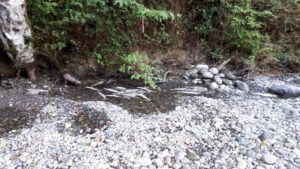
Greenwashing Hydropower: Fish Management Strategies in Canadian Hydropower
By Andrea Sutherland
Many features essential to a hydroelectric generating station are inherently harmful to fish populations. Aside from the obvious ones, like the barrier to migration, and injury from turbines, hydro dams slow the fast-moving water that some species require for spawning and flush away the eggs of others. They alter ecosystems and destroy populations through changes in water quality, and strand fish with rapidly fluctuating water levels.

Thousands of fish killed in one of many stranding events at BC Hydro’s Sea to Sky Facility. Despite the number killed, this is technically allowed under their licensing. Photo Credit: Chessy Knight, The Squamish Chief
Canadian utilities, specifically Hydro-Québec, Manitoba Hydro, and BC Hydro, frame themselves as environmental leaders in fish management, but in doing so, they often ignore that they are a big part of why that management is necessary. To their credit, Manitoba Hydro acknowledges some responsibility in a promotion for their sturgeon recovery program but in BC Hydro’s lengthy press release for a similar program, hydroelectric developments are presented as one many possible causes for the struggling sturgeon population. However, five of the seven causes of sturgeon endangerment in British Columbia, (dam construction, predation, decreased food, altered channel structure, rooted aquatic plants) can be directly linked to hydroelectric developments, while the other two, pollution and over-fishing, can be indirectly linked. BC Hydro is taking more credit for solving the problem than they are for causing it.
Meanwhile, while trying to gain approval for new developments, these corporations make questionable promises of their effects on fish communities. In discussions for both the Site C Project and the Romaine development, there was reference to an increase in fish populations following reservoir impoundment. While this may be true, it ignores the fact that species with greater value to First Nations communities are often at a greater risk of declining or disappearing altogether, and that the increase in the reservoir’s area will actually reduce the density of fish populations. For example, with Site C, fish density in the reservoir is expected to decrease to 55% of what currently exists, but if kokanee, a species that isn’t often used by the surrounding First Nations, is not included, this number becomes 16%. This will be devastating for the area’s Indigenous communities.
Hydro-Québec, on the other hand, insists that their reservoirs are similar to natural lakes. This claim is beyond misleading, and it is difficult to find information to support it. Perhaps to the unknowing observer, a reservoir is simply a lake, but those who live near them the differences are clear. They describe increased erosion and water turbidity, and reduced shoreline stability caused by increased variations in water level. Reservoirs also submerge key features of lakes – beaches, marshes, and vegetation – so it is difficult to see how the two can be equivocated. Interestingly, Hydro-Québec made this comparison in response to a documentary that argued against the development of the Romaine River. Faced with the documentary’s indictment of their corporate greenwashing, Hydro-Québec responded with the industry standard – more greenwashing.

Erosion along the shoreline of South Indian Lake caused by fluctuating water levels. Decades after the area was developed, the reservoir continues to grow. Photo Credit: Will Braun, Interchurch Council on Hydropower
Efforts to mitigate the transformation of these ecosystems are implemented, but their results can be exaggerated. Before recent major developments, there were often promises of spawning habitat compensation by remediating habitat outside of the project’s influence, but there are concerns that these modified habitats deteriorate within two years and do not have a history of success. What’s more, it can be difficult to find habitat to remediate when the project is being developed in an otherwise untouched ecosystem.
Flow management practices have been under frequent review, as well, and celebrated stocking programs are a short-term solution. They have been described as the ecosystem equivalent of life support, and they contradict the concept of renewability. Yet, it is with these programs that companies justify more developments. As was the case for Keeyask, a Manitoban hydroelectric development project, where promises were made that, thanks to the above measures, the fish community would actually benefit from the project. Many believe that this is impossible, and thus, it is greenwashing. Regardless, Manitoba Hydro is essentially holding the community hostage; either they continue to suffer with the effects of surrounding developments on their sturgeon population, or they accept the development in exchange for the potential success of mitigation strategies.
Of course, failed mitigation efforts are only half of the problem; the other half arises when these corporations continue to celebrate their efforts, make promises to affected Indigenous communities, and ignore their corporate failures. This leaves the public misinformed of the true impacts of their electricity, and it leaves Indigenous communities struggling with the loss of fish and fisheries. Hydropower companies are framing themselves as environmental leaders while simultaneously damaging entire ecosystems.
These utilities make continuous promises to limit their impact, but fail to deliver because their organizational framework revolves around high-impact developments within the Canadian wilderness. For developments of any kind, there will always be costs to society and to the environment, but on hydropower’s current scale, these costs can be devastating, and should not be ignored. Hydroelectric utilities should educate the public responsibly, which would both hold themselves accountable to their actions and allow consumers to make appropriate, well-informed demands for genuine sustainability. In failing to do so, they are undermining international efforts for a sustainable future.
Cover Photo: Hoyt Battey, Department of Energy

